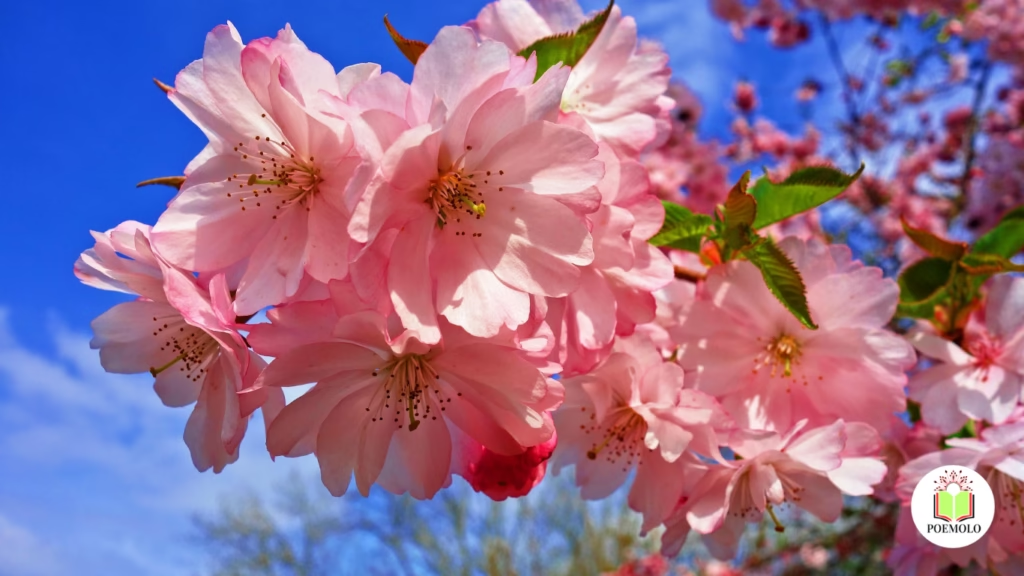Mary Oliver, a poet celebrated for her deep connection with the natural world, offers readers profound insights into life, and growth through her evocative poems. One such poem, “April Poem Mary Oliver,” invites readers to explore the beauty of spring and its significance as a symbol of renewal.
Known for her simple yet powerful language, Oliver’s poetry always reflects on themes of nature, introspection, and spirituality, and “April Poem“ is no exception.
In this article, I will explore the layers of meaning found in Mary Oliver’s “April Poem,” analyzing the themes, symbolism, and poetic devices she employs to capture the essence of the season of spring. We will also delve into the ways in which Oliver’s connection to nature informs her writing and what her readers can learn from her perspective on life and change.
Understanding “April Poem“ by Mary Oliver

Mary Oliver’s “April Poem Mary Oliver” is a celebration of the arrival of spring, but it is also a meditation on the passage of time, personal transformation, and the beauty of life’s cyclical nature.
The poem invites readers into a quiet, contemplative space where nature and the human experience intertwine. Oliver’s connection to nature is one of the most compelling aspects of her work, and in “April Poem,” she captures the sense of renewal that comes with the change of seasons.
April Poem“ by Mary Oliver
by Mary Oliver
This is the time of year when everything changes,
when the last of the snow melts,
when the buds on the trees,
almost overnight,
become leaves.
This is the time of year when you can’t help but feel
the world is beginning again.
There is a light in the air,
almost tender,
as if it could come from the very wings
of a bird.
The birds are calling,
the branches are bending in the wind,
and the sky is the color of forgetting.
It is the time when life stirs,
in the earth,
and also in us,
and begins again.
Analysis Table for April Poem by Mary Oliver
| Element | Analysis |
| Title | April Poem – The title indicates a celebration of the month of April, typically associated with spring, renewal, and growth. The poem likely explores themes tied to this season. |
| Theme | Renewal and Transformation: The poem highlights the annual arrival of spring, symbolizing the cycles of life, renewal, and personal transformation. |
| Tone | Reflective, Gentle, and Appreciative: The poem’s tone is calm and contemplative, evoking a sense of peace and renewal through its observations of nature. |
| Imagery | The poem uses vivid imagery to describe the changes that occur in nature, such as “the last of the snow melts,” “buds on the trees…become leaves,” and “a light in the air.” |
| Symbols | Spring/April – Represents renewal and new beginnings; Leaves and Buds – Symbolize growth, change, and the unfolding of new opportunities. |
| Personification | The poem personifies the season and nature, giving qualities like “tender light” and suggesting the wind and branches are “bending” or “calling,” creating a sense of life and agency. |
| Structure | Free verse – The poem does not adhere to a specific rhyme or meter, reflecting the natural, free-flowing process of spring and life’s unpredictable changes. |
| Connection to Nature | Nature serves as a reflection of human life. Oliver suggests that just as nature undergoes change, so do individuals experience periods of growth and renewal in their lives. |
| Message | The poem emphasizes the beauty and inevitability of change, encouraging readers to embrace the cycles of life, growth, and renewal, much like the changing of seasons. |
| Context | Written by Mary Oliver, known for her deep connection with nature, the poem reflects her characteristic exploration of nature’s life cycles and their relationship to human life. |
| Mood | Hopeful, Peaceful – The poem captures a sense of optimism and calm as nature awakens and begins anew, symbolizing potential for change and personal renewal. |
| Metaphors | “the sky is the color of forgetting” – The sky represents a fresh start or a release from past burdens. The metaphor suggests a clean slate or a sense of letting go. |
The Essence of spring in “April Poem“
In “April Poem Mary Oliver“ the speaker reflects on the arrival of spring, a time that symbolizes new beginnings and growth. April, traditionally associated with the arrival of spring in the northern hemisphere, is a time of renewal—both in nature and in the human spirit.
The cold, dormant months of winter give way to the warmth of spring, and in the same way, “April Poem“ explores the potential for transformation and growth. Oliver uses the imagery of spring’s natural elements, such as budding flowers, warm sunlight, and the return of birds, to evoke the feeling of freshness and the promise of new possibilities.
Spring is often viewed as a time of optimism and hope, and Oliver’s poem capitalizes on this theme. However, it does so in a subtle and quiet way. There is no grandiose celebration in the poem, but rather a gentle acknowledgment of the beauty and possibility that accompanies the season of April.
The speaker does not explicitly outline what transformation is happening but rather uses nature’s awakening as a metaphor for personal renewal.
The Poem’s Reflective Tone
One of the defining features of Mary Oliver’s poetry is its introspective and meditative tone, and “April Poem” is no exception. Through her simple yet evocative language, Oliver creates a reflective atmosphere that encourages the reader to look inward while also observing the natural world.
The poem speaks to universal themes—change, growth, and the cyclical nature of existence—that resonate with readers on a deeply emotional level.
In “April Poem Mary Oliver,” the tone is one of quiet appreciation for the unfolding changes in nature. There is an almost reverent acknowledgment of the beauty found in the everyday moments of life.
As Oliver meditates on the arrival of April, she draws attention to the gradual but inevitable process of transformation. This can be interpreted as a metaphor for personal change, suggesting that growth is not always immediate or dramatic, but rather something that unfolds over time. The poem encourages the reader to embrace these changes with patience and mindfulness.
Major Themes in “April Poem“
Mary Oliver’s poems often explore themes related to nature, the passage of time, and the human experience. “April Poem Mary Oliver“ is no exception. The poem’s themes touch on renewal, change, the interconnectedness of life, and the role of nature as both a teacher and a guide. Let’s examine these key themes in greater detail:
The Theme of Renewal
The central theme of “April Poem“ is renewal. Oliver captures the essence of spring as a time when life begins anew. April marks the transition from winter’s dormancy to the vibrant activity of the warmer months.
For Oliver, this seasonal change becomes a metaphor for the personal renewal that each individual can experience. Spring is symbolic of growth, both physical and emotional, and the poem suggests that just as the earth comes back to life in April, so too can we.
The poem’s celebration of new beginnings encourages the reader to reflect on their own potential for personal transformation.
Oliver’s use of nature to symbolize renewal is powerful because it speaks to the natural rhythms of life. Much like the changing seasons, we experience moments of growth, stagnation, and eventual flourishing.
By drawing attention to the earth’s cyclical nature, Oliver reminds us that personal renewal is not an isolated event but rather part of a larger, ongoing process. This makes the theme of renewal in “April Poem” both deeply universal and personal at the same time.
The Theme of Change
In addition to renewal, the poem also touches on the theme of change. Oliver’s portrayal of spring emphasizes that transformation is a natural part of life. As the earth shifts from winter to spring, so too do our personal lives evolve.
Change is not always easy or immediately apparent, but like the changing seasons, it is an inevitable and essential part of existence. The poem’s subtle tone underscores the idea that change is often a quiet, almost imperceptible process—one that takes time to fully unfold.
Oliver does not dwell on the challenges that come with change but instead highlights the beauty that can emerge from this inevitable process. The sense of calm and acceptance in the poem encourages readers to embrace change as part of the natural flow of life. By acknowledging the inevitability of change, Oliver invites the reader to reflect on how they themselves navigate transformation in their lives.
The Interconnectedness of Life
Another important theme in “April Poem“ is the interconnectedness of all life. Oliver often reflects on the ways in which human beings are linked to the natural world, and this theme runs throughout much of her poetry.
In the poem, the renewal of nature in April is presented as a shared experience between humanity and the earth. Oliver suggests that we are not separate from nature but are instead part of the same cycle of life. This interconnectedness is reflected in the poem’s imagery of the changing seasons and the natural world’s response to April’s arrival.
Oliver’s work often conveys a sense of reverence for the earth, and in “April Poem Mary Oliver,” she subtly reminds readers that we are responsible for our relationship with the natural world.
By observing the unfolding beauty of nature, the speaker comes to a deeper understanding of the importance of maintaining this connection and fostering a sense of care for the environment.
The idea of interconnectedness invites the reader to reflect on how they contribute to the larger tapestry of life, encouraging a sense of responsibility and mindfulness in the way we interact with the world around us.
The Role of Nature as Teacher
Finally, “April Poem“ speaks to the role of nature as a teacher. Mary Oliver often views the natural world as a source of wisdom, and in this poem, nature’s renewal serves as a model for how we can approach our own lives.
Nature, in all its cycles and rhythms, offers lessons on patience, resilience, and acceptance. In the poem, the slow unfolding of spring provides a gentle reminder that growth takes time, and that change, though sometimes imperceptible, is always in motion.
Oliver suggests that by paying attention to nature and its processes, we can learn valuable life lessons. The return of flowers, the budding of trees, and the arrival of birds all symbolize the resilience of life.
Through this metaphor, the poem encourages readers to reflect on their own capacity for growth and transformation. By embracing the rhythms of nature, we are reminded that we, too, have the ability to renew ourselves and adapt to life’s changes.
The Poetic Devices Used in “April Poem“

Mary Oliver’s writing is known for its clarity and accessibility, but it also contains deep layers of meaning. One of the reasons Oliver’s poetry resonates so deeply with readers is her mastery of poetic devices. In “April Poem,” Oliver uses a range of techniques to enhance the emotional and thematic impact of the poem. Let’s take a closer look at some of these devices:
Imagery
Imagery is one of the most prominent poetic devices in “April Poem.” Oliver uses descriptive language to paint vivid pictures of the natural world, bringing the sights, sounds, and feelings of spring to life.
Through her carefully chosen words, she evokes the colors of the sky, the softness of the earth, and the warmth of the sun. This imagery serves not only to create a sensory experience for the reader but also to convey deeper emotional truths about the cycle of life.
The imagery in the poem encourages the reader to connect with the natural world on a visceral level. By immersing ourselves in the images Oliver presents, we are able to experience the quiet beauty of April and reflect on its symbolism of renewal.
Symbolism
The symbolism of April itself is central to the poem. As a symbol of spring, April represents new beginnings, hope, and the potential for growth. The month of April marks the end of winter, a time of dormancy and stillness, and ushers in a season of vibrant life.
In this sense, April becomes a symbol of the personal transformation that can take place when we embrace change and open ourselves to new possibilities.
The natural elements that Oliver describes—the budding flowers, the warming air, and the return of birds—also function as symbols of life’s resilience and capacity for renewal. These symbols remind the reader that even in the harshest of times, there is always the potential for growth and change.
Personification
In “April Poem,” Oliver uses personification to give human qualities to elements of the natural world. By describing nature as something that responds to the arrival of spring, Oliver imbues the earth with life and agency. The trees, flowers, and sky are not passive observers of the changing season; they are active participants in the process of renewal.
This personification invites readers to see nature as something dynamic and alive, not merely a backdrop for human activity. It encourages us to recognize the agency of the natural world and to understand our place within it.
Conclusion
In “April Poem Mary Oliver,” Mary Oliver offers a powerful reflection on the beauty and significance of spring, using the season of renewal as a metaphor for personal transformation. Through vivid imagery, symbolic language, and a reflective tone, the poem captures the quiet yet profound changes that take place in nature and in the human experience.
The themes of renewal, change, and nature’s wisdom are explored with grace and simplicity, inviting readers to reflect on their own lives and the cycles of growth and transformation they experience.
Oliver’s connection to the natural world is evident in every line of the poem, and her ability to capture the quiet beauty of life’s moments makes her one of the most beloved poets of our time. “April Poem“ serves as a reminder that, like the earth in spring, we too have the potential for renewal and growth, and that the natural world offers valuable lessons in resilience, patience, and change.
By reflecting on the poem’s themes, readers can gain a deeper understanding of the beauty and wisdom that surrounds them every day. “April Poem“ encourages us to embrace the changes in our lives with openness and acceptance, recognizing that just as nature renews itself with each season; we too can find new opportunities for growth and transformation.





